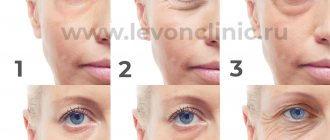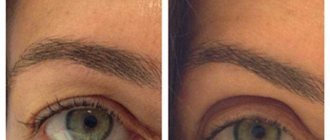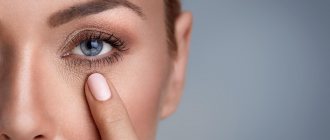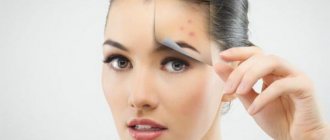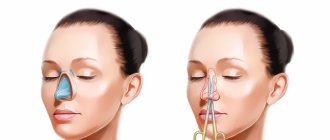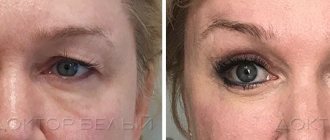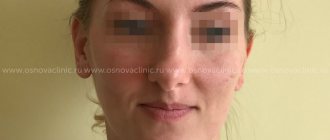January 07, 2020
Structure
- Tired of struggling with bags under your eyes?
- How to get rid of hernias using cosmetic procedures?
- Blepharoplasty of the lower eyelids – guaranteed relief from bags and hernias under the eyes
- Methods of performing lower blepharoplasty at the Beauty Doctor clinic
- Photos Before and After Lower Blepharoplasty
- Where are the incisions made and will the scar be visible after blepharoplasty?
- Can there be complications after lower eyelid surgery?
- How is rehabilitation after lower eyelid blepharoplasty?
- Cost of lower blepharoplasty
Tired of struggling with bags under your eyes? Do Lower Eyelid Hernias Make You Ten Years Older?
Nothing ages the face more than bags under the eyes.
They not only mercilessly take away years, but also create the wrong impression about a person. Willy-nilly, the interlocutor, looking in the face, thinks either about illness, or about an addiction to alcohol.
In fact, a person with bags under his eyes can be absolutely healthy and, moreover, very moderate in his habits.
But crumpled skin, a swollen crease under the eye, hanging in a semicircle over the cheekbone - all this looks unsightly.
The cause of a lower eyelid hernia may be a hereditary predisposition or age-related weakening of the orbicularis oculi muscle.
In this case, the fatty tissue that carefully surrounds the eyeball is squeezed out under a thin layer of skin (and on the lower eyelid it is really very thin!) and creates such flaccid grayish bags that are located in the most visible place of the face.
Hernias make the face look much older, the person looks tired, unhealthy and stale. It is not for nothing that such persons are spoken of as shabby clothes: his trousers are wrinkled; his face is crumpled!
CONTRAINDICATIONS
- Acute and chronic diseases of the eyelids, dry eye syndrome
- High intraocular pressure
- Diabetes mellitus in the stage of decompensation
- Impaired function of the cardiovascular system, kidneys
TRANSCONJUNCTIVAL EYELIDPLASTY
| NAME | Price, white rubles |
| Transconjunctival blepharoplasty | 2000 |
Vladimir Aleksandrovich Kosinets conducts consultations in Minsk and Vitebsk. You can make an appointment by phone +375 25 902 19 44.
How to get rid of hernias using cosmetic procedures?
At first, patients go to a cosmetologist with this problem, habitually thinking that this is one of the aesthetic flaws that can be corrected in a beauty salon.
However, this is not true - neither stretched skin, nor, especially, fatty tissue can be removed using therapeutic methods.
Moreover, you should not rely on hardware techniques: the thinner the skin under the eyes, the more likely it is that it will become even thinner and lifeless after aggressive procedures. Underneath there is no dense layer of subcutaneous fat, where the life-saving formation of a new collagen framework is possible.
Covering up the circles and bags under the eyes with thick foundation doesn’t help either; it only works if the lighting in the room is low.
Sometimes desperate people start pumping gels into the cheekbones, trying to even out the surface, and in this case, their facial contours and its natural harmony simply change. Puffiness of the face has never rejuvenated anyone.
Treatment
According to statistics, treatment of chalazion takes from 2 weeks when diagnosed in the early stages to several weeks if the disease is diagnosed in an advanced form. If you contact an ophthalmologist before the formation of a dense capsule, treatment is carried out using simple means and the tumor is eliminated in the same period as with barley, that is, 2-5 days. However, in practice this happens extremely rarely, because before the gland is encapsulated, the chalazion is practically invisible and does not cause discomfort.
At the initial stages, chalazion treatment is carried out using antiseptics, antibiotics and anti-inflammatory drugs in the form of drops and ointments. They can be single-component or contain additional substances that enhance the effect of the main components.
The most effective are:
- ointments and drops with antibiotics - “Vigamox” (active substance moxifloxacin), “Floxal” (ofloxacin), “Oftaquix” (levofloxacin), “Tsiprolet” (ciprofloxacin);
- combination drugs with antibiotics and hormonal anti-inflammatory substances - “Tobradex” (tobramycin with dexamethasone), “Floxadex” (ciprofloxacin with dexamethasone), “Garazon” (betamethasone with gentamicin).
In most cases, doctors tend to use combination drugs, especially if the chalazion has become chronic or recurrent. Such agents actively suppress pathogenic microflora, reduce inflammation and prevent purulent complications. When prescribed in a timely manner, medications from this group relieve swelling from the walls of the meibomian gland ducts and restore the outflow of secretions.
If the neoplasm is not bothered by unpleasant symptoms and there are no signs of inflammation, ophthalmologists recommend physiotherapy, combining gentle dry heating of a pea with subsequent massage of the eyelid. Warming can be performed in a clinic or private clinic with special equipment. At home, it can be replaced in the following ways:
- place a fabric bag with salt or sand heated in a frying pan on the eyelid for 5-10 minutes;
- iron the cotton fabric with a heated iron and apply it to the eye until it cools, repeat 5-7 times.
Gentle heating helps to soften the thickened secretion, which comes out of the duct during subsequent massage.
Important to remember
that this method cannot be used to treat a chalazion that has arisen against the background of an infection of the eye, as well as one that occurs with obvious inflammation of the meibomian gland. The methods are suitable for eliminating pathology caused by metabolic disorders, chronic gastrointestinal diseases, etc.
After the procedure, you need to rinse the eyelid with warm water using a cotton pad or sterile napkin. After washing, you can treat the eye with any antiseptic. You can also use:
- “Blepharogel” with hyaluronic acid to restore the structure and moisture of the eyelids;
- “Blephaclean” eye hygiene wipes with antiseptics, hyaluronic acid, antioxidants and substances that regulate the activity of the sebaceous glands.
These products can be used not only after a massage, but also during it. The active substances in their composition help soften the sebaceous secretion of the glands and remove it from the ducts of the glands. Despite the enormous benefits for eye health, it is recommended to use them no more than twice a day.
If the chalazion is opened on your own, it is recommended to continue therapy according to the regimen prescribed by the doctor. To prevent infection of the resulting wound, quickly and efficiently cleanse the capsule and tissue regeneration, it is recommended to use:
- drops with antibiotics - “Signitsef”, “Tobrimed”, “Uniflox”;
- ointments with antibiotics - tetracycline, Floxal, erythromycin;
- corticosteroids in the form of ointment - “Hydrocortisone” 0.5%, “Combinil Duo”, “Floxadex”;
- homeopathic ointment "Traumel".
If conservative methods do not lead to improvement or there is a tendency for the tumor to grow, surgical methods are used to treat chalazion. For children, operations are performed under general anesthesia, and for adults, under local anesthesia. There are several methods for removing tumors:
- Classical desquamation of the capsule and its contents.
To carry it out, the doctor makes an incision in the skin of the eyelid and through it, using a curette (a curved sharp instrument), scrapes out the chalazion, then cleans the cavity, treats it with antiseptics and applies sutures. The intervention lasts no more than 15 minutes. The sutures are removed after 5-7 days. - Enscaping the capsule through an incision on the inside of the eyelid
. The doctor everts the eyelid, makes an incision and performs the procedure as in the previous case. There are no stitches with this method. For better healing and prevention of infection, apply antibiotic ointment behind the eyelid and cover the eye with a sterile bandage. - Laser removal of chalazion
. The doctor makes an incision on the outer part of the eyelid and evaporates the capsule with its contents layer by layer. Treatment with antiseptics and sutures are not necessary for this type of intervention - they will be replaced by a scab formed by the action of the laser on the tissue.
After any intervention, slight swelling remains in the eye for a week, and the patient may experience moderate pain.
Blepharoplasty of the lower eyelids – guaranteed relief from bags and hernias under the eyes
Hernias of the lower eyelids are one of those aesthetic defects for which the only method of correction is indicated - surgery.
Blepharoplasty is eyelid surgery to remove skin ptosis and fat folds. The name of the operation literally means “formation of the eyelid” (from the Greek blepharon - eyelid and plastike - formation). Therefore, the expression “lower eyelid blepharoplasty” is not entirely correct, and a more correct name for this operation is lower blepharoplasty.
Lower blepharoplasty radically changes the overall appearance of the face , and men resort to it no less often than women (while women wear out foundation, men go straight to the goal!). Many of our public politicians have already undergone blepharoplasty to maintain a vibrant, youthful face.
The operation of blepharoplasty is not so complicated, but it has its own characteristics, its own rules, the observance of which will allow the correct formation of the eye shape.
What are these features? An experienced surgeon understands that it is important not to overtighten the skin, not to excise excess, so that the lower edge of the eyeball does not “roll out” beyond its boundaries: in this case, the impression of bulging, sphericity is created.
Prevention
To prevent chalazion, it is enough to maintain visual hygiene:
- thoroughly clean your eyelids after sleep;
- remove makeup before going to bed;
- do not apply cosmetics and creams along the edges of the eyelids and in the eyelash line;
- store contact lenses in sealed, sterile containers with fresh solution;
- pick up and install lenses with clean hands or a sterile instrument;
- do not touch your eyes with dirty hands;
- if you are prone to inflammation of the eyelids, use “Blepharogel” and “Blephaclean” wipes for daily eye care;
- promptly eliminate problems with digestion, metabolism and hormonal imbalances;
- avoid hypothermia.
If you find a small hailstone on your eyelid, you should immediately go to an ophthalmologist with the problem in order to have time to deal with it using conservative methods.
Methods of performing lower blepharoplasty at the Beauty Doctor clinic
Plastic surgeons at the Beauty Doctor clinic are proficient in all modern blepharoplasty techniques, including classical, transconjunctival, canthoplasty, canthopexy, lipofilling...
However, the choice of technique is always the right of the doctor, not the patient, because only an experienced specialist is able to correctly plan the intervention and predict its result.
But no matter what technique is used, the main thing remains unchanged at the Beauty Doctor clinic - all sutures are applied with the thinnest threads using special optics, which makes it possible to make the suture line almost invisible from the first days after the operation .
Experienced surgeons at the Beauty Doctor clinic use fat-saving technology of lower eyelid blepharoplasty , in which fatty tissue is not removed, but is evenly distributed under the skin so that the eyelid is not sunken, but alive, young, smooth, with a smooth transition from the eyelid to the cheek.
This technology is used in leading plastic surgery clinics in Europe and the USA; our surgeons have mastered it perfectly during their internships in foreign clinics and at master classes at international symposiums on plastic surgery.
The Beauty Doctor clinic uses special physiotherapeutic equipment that allows you to remove bruises and swelling in the shortest possible time. It is used from the second day after surgery. The cost of rehabilitation is included in the total price of blepharoplasty surgery .
Diagnostics
The use of instrumental methods to diagnose chalazion is not required, since even an inexperienced ophthalmologist can distinguish this pathology from other eye diseases. When interviewing the patient, the doctor will find out:
- is there pain when blinking - its absence is interpreted in favor of blockage of the meibomian gland duct;
- is there any sticking of the eyelid with yellow, white or greenish pus in the morning - with a chalazion this phenomenon should not occur;
- how long ago the tumor was first noticed - a period of more than 2 weeks is interpreted in favor of the described pathology.
Next, the doctor examines the eye: palpates the affected eyelid, turns it inside out to examine the inner surface. To determine the causes of chalazion, the ophthalmologist may prescribe additional tests:
- laboratory blood tests (general clinical, biochemistry) to identify endocrine, metabolic, infectious and other disorders;
- bacteriological blood culture for pathogens of systemic infections;
- culture of a smear from the eyelid for staphylococcal infection;
- inoculating a smear from the eyelid for pathogens of gonococci, trichomonas and other pathogens of STIs that can affect the mucous membranes of the eyes;
- stool analysis for eggs of worms, lamblia and other parasites;
- microscopic analysis of epithelial scrapings for demodex and other skin parasites;
- immunological screening.
The doctor may not necessarily prescribe all of the tests listed. It is enough to limit ourselves to the most probable causes of the pathology identified during the collection of individual and family analysis. In most cases, the doctor limits himself to a general clinical blood test and referring the patient to a consultation with a dermatologist and therapist.
Photos Before and After Lower Blepharoplasty
Where are the incisions made and will the scar be visible after blepharoplasty?
Typically, patients are very concerned about the question of whether the scar will be visible after lower eyelid blepharoplasty? There is only one answer - if the operation is performed by an experienced surgeon, the closest look from the outside will not detect traces of the intervention .
There are two ways to perform blepharoplasty of the lower eyelids: - without external incisions, when all manipulations are performed through the mucous membrane on the inside of the eyelid, - with an incision in the subciliary area, which will also not be noticeable in the future, because it is made along the line of the natural border.
Surgeons at the Beauty Doctor clinic always choose the method of access, taking into account the patient’s age, skin condition, and the presence of local problems to eliminate excess skin of the lower eyelid.
Causes
The main cause of a chalazion is a blockage of the meibomian gland duct.
followed by an inflammatory process. In most cases, the source of the problem is primary inflammation of the eyelid margin or the gland itself. Chalazion also has secondary causes, that is, not related to eye diseases. Among them, doctors call somatic pathologies:
- the digestive system, in which lipid metabolism is disrupted, and the synthesized fat secretion becomes excessively thick, viscous, and prone to accumulation in the ducts;
- chronic infectious skin diseases - seborrhea and demodicosis, in which parasites and inflammatory processes lead to scarring of the ducts, their gradual narrowing and disrupt the outflow of secretions;
- endocrine diseases, in particular diabetes mellitus, in which immune defense is disrupted and the activity of microorganisms on the surface of the eye and mucous membranes of the eyelids increases;
- deficiency of certain vitamins;
- congenital features associated with increased activity of the sebaceous glands - according to statistics, those with oily skin are more likely to suffer from eye chalazion.
Another common cause of chalazion
is a violation of eye hygiene:
- improper storage and installation of contact lenses;
- contact of dirty hands with eyes;
- using low-quality or expired eye drops;
- using non-sterile tools to create makeup, etc.
Chalazion can also develop against the background of oncology of other organs or the eyelid itself. In the first case, the neoplasm occurs after chemotherapy due to a general decrease in immunity, and in the second it can be a malignant neoplasm, which is mistaken for a chalazion.
Can there be complications after lower eyelid surgery?
In a plastic surgery clinic with an experienced team of specialists, the risk of complications is minimized.
There is no need to worry about vision problems, since the surgeon does not touch the eyeball in any way.
However, aesthetic complications are still possible after this operation. For example, in the case of excessive tissue excision, the eyes change shape, become round, and the skin around them is unnaturally stretched, as if theatrical makeup was applied in layers to the face.
This complication is difficult to correct, but in some cases it is possible. Thus, in the practice of the leading surgeon of the clinic, Zaur Bytdaev, a significant percentage of blepharoplasty operations are just a correction after an unsuccessful excision done somewhere in another operating room.
What is fractional laser treatment?
Lasers operate in different modes, not just scalpel mode.
The essence of the fractional mode is that the laser beam is divided into many small beams (from 100 to 1,000). When treating the eyelid area, the laser makes microscopic holes around the eyes - nanoperforations.
Light spots are holes in the skin after exposure to a fractional laser.
These laser procedures are called “laser eyelid surgery” or “non-surgical laser blepharoplasty.”
In this case, fractional eyelid blepharoplasty is not a surgical procedure. The effect occurs only on the skin. There are no incisions and usually only local anesthesia is used.
The words "plasty" and "blepharoplasty" for this procedure are used to emphasize the surgical-like effect that modern fractional lasers have on the skin around the eyes.

